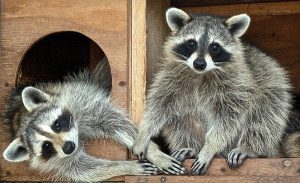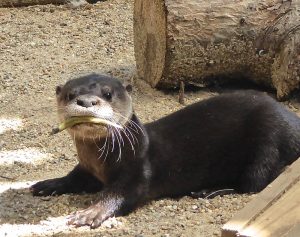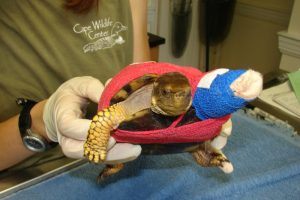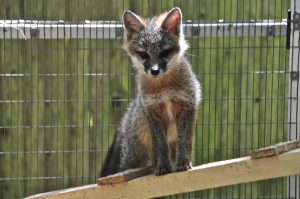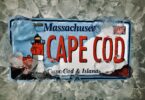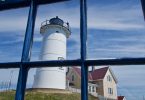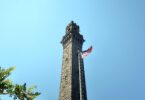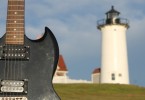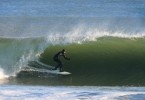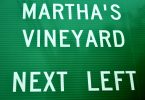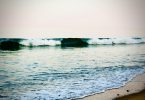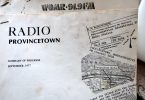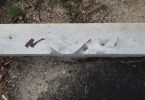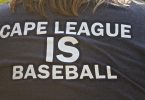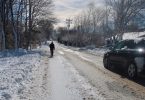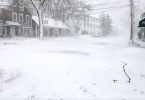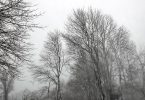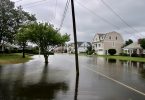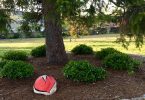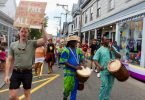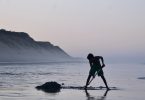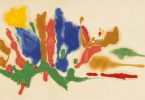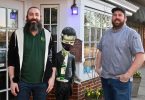BARNSTABLE -On a recent morning, Barnstable Department of Natural Resources Officer Amy Croteau was checking on a wandering rooster in West Barnstable when she got a call for a injured swan on a road in Hyannis.
The rooster was returned to a local feed and grain store, and Croteau responded to Scudder Avenue where she found a young swan that had likely been hit by a car and was now walking on the sidewalk.
“She was definitely compromised,” Croteau said, adding that one side of the swan appeared to bear the brunt of the injury.
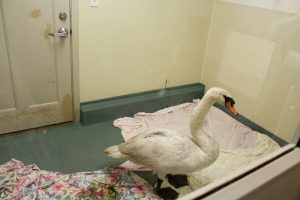
An injured swan is in rehab at Cape Wildlife Center, having been brought in by Barnstable Department of Natural Resources Officer Amy Croteau. CAPE COD WAVE PHOTO.
Barnstable police, who had also been dispatched to the call, created a blockade so Croteau could catch the swan, using a net flung over its head and then draping a blanket over its body—what Croteau called “a swan burrito wrap”—to keep it calm.
Croteau put the swan into a carrier tub in the trunk of the DNR vehicle and brought to Cape Wildlife Center on Route 6A in Cummaquid, the region’s sole facility for large animal wildlife rehab.
Once at the center, the swan’s torso was x-rayed to determine whether it had been shot. When the x-ray came up negative for lead, Croteau said, the assumption was that she had been hit by a car.
On an early November day at the center, that rescued mute swan from Scudder Avenue was there as a patient, and when volunteers looked in on her, the swan hissed with with a vigor that perhaps indicated its rehab was proceeding on schedule.
In another area of the center, an osprey was awaiting transport to Fort Lauderdale, having missed the opportunity to migrate south for the winter. Also at the facility on this day were a herring gull, a red Eastern screech owl, a turkey vulture, a fox and two otters.
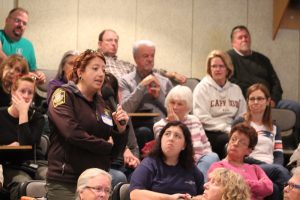
Barnstable Department of Natural Resources Officer Amy Croteau speaks at a meeting for people concerned about the potential closing of Cape Wildlife Center. CAPE COD WAVE PHOTO.
Croteau said this example of the recently rescued swan illustrates the urgent need for a wildlife center on the Cape.
When a wild animal is injured, time is of the essence.
Knowing how often her department relies on the center, Croteau said she was taken aback when she heard last month that it would be closed down.
Since its parent organization, the Humane Society of the United States first announced the closing, citing financial reasons, an outcry from supporters has resulted in Cape Wildlife Center being given three months to raise, ideally, at least a million dollars, in order to keep going. It’s a tall order but one that has energized hundreds of supporters of the center.
“This new development [of three months before the center closes] gives us time to come up with a solid game plan,” Elizabeth Brooke from Provincetown, an organizer of efforts to save the center, said.
Until February 28, the Wildlife Center is allowed to continue to operate on the Cummaquid property with a skeleton staff of three, with two of them part-time, and its 90 plus volunteers.
Brooke said, “We’re working together for a viable alternative after February 28. Our success depends on volunteers and other wildlife organizations and of course money. As a united community, we will solve this together.”
When the Humane Society decided to close the Cape Wildlife Center last month, it notified the seven-member staff that they would be laid off and it gave the 20-year-old center a month to shut its doors and clear out.
But as word spread and supporters reacted with concern, animal welfare champion and philanthropist Barbara Birdsey swooped into to save the agency, donating enough money to keep it going for three months while supporters try to start a new nonprofit and fundraise enough to get a new animal rehab nonprofit off the ground. It was Birdsey’s donation of another Cape Cod property to the Humane Society for $1 that allowed the organization to purchase the Cummaquid estate for Cape Wildlife Center in the first place.
Birdsey offered a $70,000 lifeline to keep the center afloat until February 28 while supporters and volunteers put together a plan to keep the operation going.
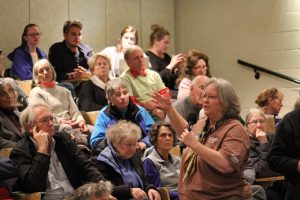
Elizabeth Brooke, one of the leaders of a group hoping to save Cape Wildlife Center, speaks at a gathering of supporters earlier this month at Cape Cod Community College. CAPE COD WAVE PHOTO.
“Basically it’s a stay of execution,” Brooke told a standing room only crowd at a November 13 meeting at Cape Cod Community College.“They gave us 30 days to close and we went into shellshock.”
The plan is to organize, fundraise and formulate a plan to put together a new nonprofit to carry on the work of the center. That work, rehabbing injured wild animals on Cape Cod, brought the center an average of 2,000 animal patients a year, everything from raptors, turtles, foxes to otters.
In addition, the center handles another 8,000 phone calls about distressed wildlife every year.
The facility gets many calls from people who are on the spectrum of concerned to upset to frantic saying, for example, “I found this bird. What do I do?” With expert advice by phone, those animals are also supported by the facility.
The center occupies a five-acre estate property in Cummaquid, the former home of ne’er-do-well former priest Bernard Kelly, who served as a witness in a Falmouth murder trial and was later discovered to have stolen funds from parishes in Woods Hole and Wellfleet. Back in 2006, he sold the property to the nonprofit for about $1.5 million to help pay restitution for the embezzled funds.
But the animals given a second chance at life know nothing of the wayward priest. They will soon be released into the wild and given an opportunity to continue to be a part of the Cape’s diverse ecosystem.
Tom Donegan, a member of the Provincetown Board of Selectmen who served as moderator for the meeting at the college, offered what he called a “reality check” to those gathered.
Creating a new 501c3 takes eight months to a year, he said. The center at a reduced level of staffing but the same caseload of 2,000 animals a year, will need $500,000 annually to operate. With reduced admissions and a three-person staff, it will need at least $300,000 per year.
“We have a capacity for 2,000 patients but a budget of zero starting on March 1,” he said. The target, Donegan said, is to raise $3 million to keep the operation running for three years.
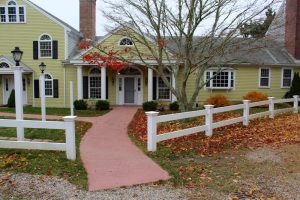
The entrance to the Cape Wildlife Center, which is located off Route 6A in Cummaquid, a village in Barnstable near the Yarmouth town line. CAPE COD WAVE PHOTO.
A new vision of the facility, Donegan said, includes making better use of the sprawling facility with, perhaps, tours, afternoon teas, educational courses, a summer camp, renting out office space and holding events. All ideas are on the table, he said.
Heads of other wildlife organizations, like Stephanie Ellis from Wildcare in Eastham, which rehabs only small animals, and National Marine Life Center, which rehabs marine animals, also pledged their support at the college meeting.
Ellis said, “We were absolutely shocked to hear about Cape Wildlife closing. We are thrilled to buy some time to think about how to sustainably care for all wildlife on Cape Cod.”
While the Humane Society would not authorize any staff to give press interviews or tours, the site is open to members of the public bringing in injured wildlife. Among the top users of the facility are Department of Natural Resources and Animal Control staff from Cape towns, like Croteau, who recently brought the swan to the center.
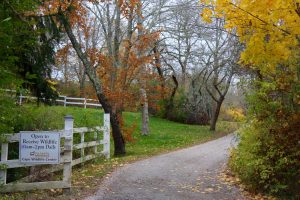
The center is open for the public to bring injured, ill or orphaned animals of all sizes. CAPE COD WAVE PHOTO.
Croteau said her department takes at least five animals a week to the center. In fact, of the 2,000 animals brought to the center in 2015, about 1,300 were from the town of Barnstable, she said.
“It’s an extremely important resource in our town,” she said.
When faced with the prospect of the center closing, she said her staff was left with few alternatives. “When we go through options, they are extremely limited, costly, time inefficient and not geared to animals in need of triage.”
As to the need to save an injured wild animal when death is also a natural outcome, Croteau is quick with a response. The majority of animal injuries she and her staff are dealing with are not natural at all to wildlife, she said.
“It’s not natural for wildlife to to die because of an overpopulation of humans using roads and running them over. We humans have had such a negative impact on our wildlife,” she said.
She pointed to cases of raptors being poisoned by rodenticides or flying into windows, and foxes and coyotes being hit by cars as examples of wildlife being injured by causes that are not at all natural.
Another important reason for a wildlife center, Croteau said, is as a place to bring what are called rabies vector species. The animals are captured and treated for rabies so the disease does not spread.
Perhaps one key to whether Cape Wildlife is successful in its rebirth lies with its passionate volunteers, including retirees, as well as members of the Cape’s workforce, who volunteer on weekends.
One a recent morning, sisters Cindy Marvin of Yarmouthport and Shari Fecteau of South Yarmouth, among the more than 90 volunteers who help out at the center, were hard at work at the facility.
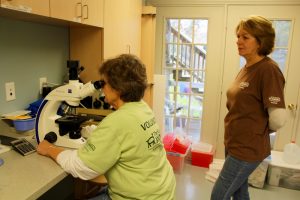
Cindy Marvin looks for parasites in a fecal sample of a wild animal patient while her sister Shari Fecteau looks on. Both are volunteers at the Cape Wildlife Center. CAPE COD WAVE PHOTO.
There is a camaraderie among volunteers, the sisters say, but what most unites them, the common denominator among volunteers, is “a compassion for animals.”
“We’re all very concerned,” Marvin said.
Marvin has been volunteering for Cape Wildlife on and off for about five years, while Fecteau just started this year. “We clean animal cages, feed them—“I’m like a mini chef” and assist them any way we can, keeping the facility clean and operational.”
With reduction of the seven member staff to just one and a half staffers, volunteers are being trained to do more than just triage and the property’s extensive areas for wildlife all require attention.
On the grounds, there are cages that reach the tree tops for birds, and a release pond for rehabbed geese and ducks. In the main building, there’s the x-ray machine, “We get a lot of broken wings,” Marvin said. The clinic is for triage, as well as surgery and intensive care. There is a laboratory for testing.
Facilities also include an isolation room for animals with contagious diseases, an indoor seabird pool, a nursery for small mammals and an avian nursery, as well as a turtle room. There is even a garden to grow vegetables to feed the animals.
There are four outdoor aviary habitats, three small mammal habitats, three large mammal habitats, three raccoon areas and a large outdoor saltwater pool. The barn includes a rabies vector area for coyotes, foxes and fishers. Upstairs is an area for bats.
On a recent day, Marvin said she spent time cleaning as well as using the microscope to look at fecal material and checking for parasites. The tasks may be menial but, she said, she is happy to do it for such a special cause. Her sister agreed.
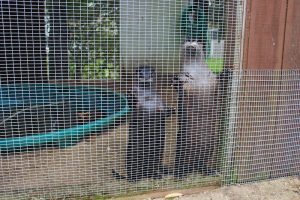
A pair of rehabbing otters are curious about visitors to their cage at the Cape Wildlife Center. CAPE COD WAVE PHOTO.
“Just the whole idea of it. It’s to take a wild owl who is injured and get him or her back to the wild. Rehab, that’s what we do,” Fecteau said.
She recalled her favorite animal the center has rehabbed recently, a gannet, a seabird who had “beautiful blue eyes.” He had a bad wing but after a rehab that lasted most of the winter, he was able to be released at Sandy Neck Beach.
“It was bittersweet,” Fecteau recalled of the release. “It flew a little, got its wings back. It looked back and then took off. It was like, ‘Yeah, goodbye.”
As for Marvin’s favorites, “I’m a mammal girl. Raccoons are quite comical. I actually like bunny rabbits. They’re very fragile, though and highly stressed.”
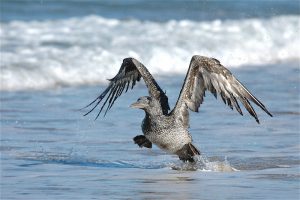
A juvenile norther gannet being released after rehab at Cape Wildlife Center. PHOTO BY HEATHER FONE.
And if an animal’s really injured, Marvin explained, “We’ll euthanize it so it doesn’t have to suffer in the wild.”
Business really picks up for the center in the spring, Marvin said. That’s baby animal season, “when you have your baby squirrels, baby bunnies, possums, an influx of orphan babies and a lot of seabirds.”
Ironically, that is when the center will close if the fundraising effort is not successful.
This kind of work is especially important on Cape Cod, according to Marvin, because part of this peninsula’s appeal is its natural beauty. “It’s all part of the ecosystem,” she said. That ecosystem is upset, she said by the death of numerous animals from human causes.
With most of the animals injured by cars, Marvin said it is the duty of humans to step in to try to help injured wildlife.
“Somebody’s got to care,” she said.
As for the future of the effort to save the agency, Marvin said, “We’re all optimistic.”
Fecteau added, “I think we’re on the right path. I think we have momentum.”
To support the rebirth of Cape Wildlife Center, go to pegasusfoundation.org. A meeting for volunteers is scheduled for December 7 at the Cultural Center of Cape Cod at 307 Old Main Street in South Yarmouth.

